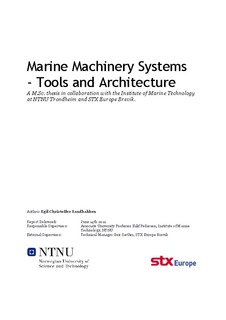| dc.description.abstract | The thesis presents tools and architecture regarding design of marine MSs in OSVs. It enlightens important aspects regarding the design based on a research study, and proposes a design methodology consisting of tools and architecture.
From the research studies in chapter 2 it becomes clear that the most common propulsion system today for platform supply vessels (PSV) is the diesel-electric (DEL) propulsion system. Other concepts such as; dual fuel engines, Voith Schneider Propellers (VSP), hybrid systems, fuel cell power, wind power, nuclear power, and jet propulsion exist today but is not yet considered typical solutions.
The research study in chapter 5, regarding current status on tools and architecture, shows that it exist very few dedicated and sophisticated tools and methodologies regarding early-design of MSs onboard OSVs. However, exceptions such as the software package GES, developed by TNO in Holland, were found and it is considered the most promising tool yet based on this study.
GES share the same design philosophy as the proposed tool in chapter 8, which is regarding the MS as an energy system where power flow through components is modeled with respect to the bond graph theory. By utilizing the bond graph theory, unified interfacing is introduced. This approach is applicable in any energy domain and the variables describing the energy or power are kept in a general form; effort and flow.
The proposed methodology, in chapter 7, presents structure and methods regarding the design process such as; concurrent engineering, hierarchical MS breakdown structure, component library scheme, and model documentation framework.
The thesis presents, in chapter 8, a MS mock-up with a hierarchical system structure and unified interfacing between components. The mock-up is flexible in terms of sub-system or component reconfigurations and it allows for energy domain-independent performance analysis which is exemplified in chapter 8.5 and 8.6.
The MS mock-up is considered far from complete in terms of user-friendliness, sub-system description, and component description, but it portraits trend lines regarding performance which are similar to what one may find by analyzing real MSs, which is considered the goal for developing this mock-up.
The presented mock-up and methodologies are meant to exemplify how one can approach this challenge. | nb_NO |
